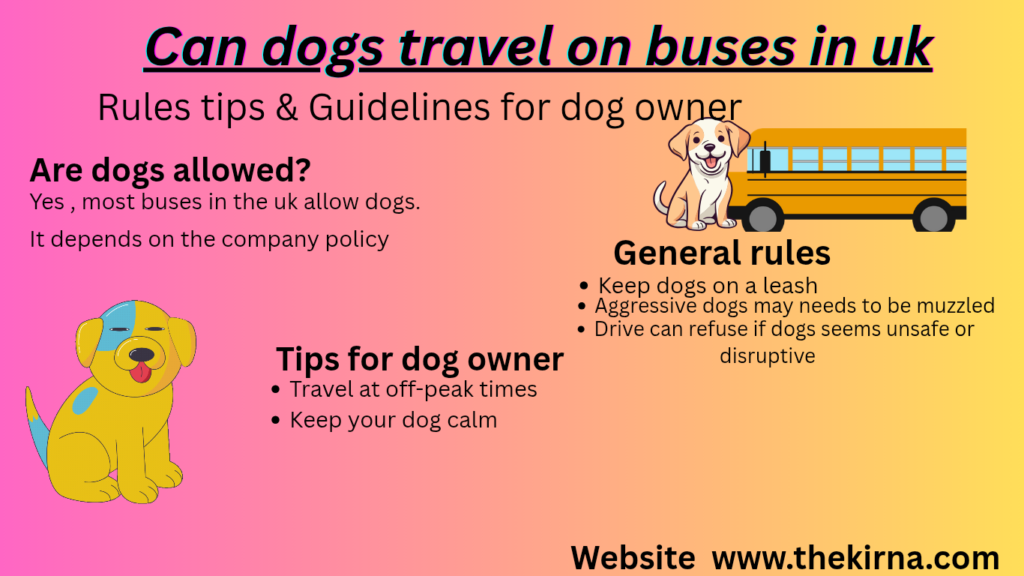Introduction
Travelling with your furry friend can be a wonderful experience, but it often comes with questions about rules and convenience. If you’ve ever wondered, Can dogs travel on buses in the UK? you’re not alone.
More and more pet owners are exploring pet-friendly travel options, whether for daily commutes, weekend adventures, or simply running errands with their four-legged companions. Public transport can be a great way to get around without the hassle of driving, but understanding the policies for pets is key to a smooth journey.
In recent years, the UK has seen a rise in pet owners wanting to include their dogs in their travel plans. Buses, being one of the most common modes of public transport, are a natural choice for many. However, policies can vary depending on the region, bus operator, and even the type of service. While some companies welcome dogs with open arms, others may have restrictions in place.

This guide will help clarify the rules, tips, and best practices for taking your dog on a bus in the UK, ensuring both you and your pup have a stress-free ride. So, if you’re planning your next trip and want your canine companion by your side, keep reading to find out everything you need to know!
General Rules for Dogs on UK Buses
Travelling with your furry friend by bus in the UK is usually allowed, but policies can differ depending on the bus company. Most major operators, including Transport for London (TfL), National Express, and local bus services, permit dogs on board, though some may have specific conditions.
Smaller regional operators might have their own rules, so it’s always best to check before your journey. Generally, passengers can bring one dog per person, provided the dog is well-behaved and doesn’t cause a disturbance.
Smaller dogs may need to sit on your lap, while larger dogs should stay on the floor at your feet without blocking aisles or exits. For safety, dogs are usually required to be on a lead, and some operators may ask for a muzzle, especially for larger breeds.
There may also be restricted areas—for example, some double-decker buses don’t allow dogs on the upper deck. Additionally, drivers have the right to refuse entry if the bus is too crowded or if the dog poses a risk to other passengers. Service dogs, however, are almost always permitted without restrictions under UK equality laws.
By following these guidelines, you and your dog can enjoy a smooth and hassle-free bus journey across the UK!
Service Dogs: Legal Rights
In the UK, service dogs have clear legal protections that allow them to accompany their handlers on buses and other public transport. Under the Equality Act 2010, businesses and transport providers cannot refuse entry to a properly trained assistance dog. This law ensures that individuals with disabilities have equal access to services, including public transport.
It’s important to note that only recognized assistance dogs—like guide dogs, hearing dogs, or medical alert dogs—are fully covered by this law. These dogs undergo rigorous training to perform specific tasks for their handlers. On the other hand, emotional support animals (ESAs), while beneficial for mental well-being, do not have the same legal rights in the UK. Transport providers may allow ESAs at their discretion, but they are not legally required to do so.
| Bus Company | Are Dogs Allowed |
| National Express | Yes☑️ |
| Megabus | Yes☑️ |
| Stagecoach | Yes☑️ |
| Arriva | Yes☑️ |
| First Bus | Yes☑️ |
| Scottish Citylink | Yes☑️ |
| TFL(Londan Buses) | Yes☑️ |
Documentation isn’t mandatory by law, but many handlers carry an assistance dog ID card or wear a branded harness to avoid disputes. Trainers often provide certification, but the key factor is the dog’s behavior—if the dog is well-trained, calm, and doesn’t disrupt others, refusal could be considered discrimination.
If a bus driver or company denies access to a legitimate service dog, the handler can challenge the decision under the Equality Act. Always check with individual transport operators for specific policies, but remember—the law is on your side when it comes to trained assistance dogs.
Bus Company-Specific Policies
If you’re thinking, Can dogs travel on buses in the UK? The answer depends on the bus company you’re using. Each operator has its own rules, so it’s important to check before your journey. For example, Transport for London (TfL) allows dogs to travel for free on buses, with no restrictions on size or breed.
Your furry friend can hop on and off without any hassle. On the other hand, National Express only permits small dogs that can fit in a carrier, while larger dogs may be refused unless they’re assistance animals. For local and regional services, policies vary. Companies like Stagecoach, FirstBus, and Arriva often allow dogs at the driver’s discretion, but some may charge a small fee or require them to be leashed and well-behaved.
Always check the company’s website or call ahead to confirm their pet policy. So, if you’re planning a trip and asking, “Can dogs travel on buses in the UK?” the key is to research the specific bus operator’s rules to ensure a smooth ride for you and your pup!
Tips for Stress-Free Bus Travel with Dogs

Travelling with your dog on buses in the UK can be a smooth experience if you plan ahead. Many bus companies allow dogs, but rules may vary, so it’s best to check beforehand. To ensure a comfortable journey for both you and your pet, avoid peak hours when buses are crowded.
A quieter ride means less stress for your dog and fewer distractions for you. Always keep your dog on a leash and close to your side to prevent them from wandering or bothering other passengers. A well-behaved, calm dog makes the trip easier for everyone.
Bring essentials like a portable water bowl, waste bags, and a small towel in case of messes or wet paws. If your dog isn’t used to bus travel, practice short trips first to help them adjust.
Good etiquette goes a long way—make sure your dog doesn’t block aisles or seats, and be mindful of passengers who may be nervous around pets. A little consideration ensures a positive experience for all. With these simple steps, bus travel with your furry friend can be hassle-free and enjoyable!
Challenges and How to Handle Them
Travelling with your dog on buses in the UK can be a convenient way to get around, but it’s not always smooth sailing. While many bus companies allow dogs, you might face a few hurdles along the way. Knowing how to handle these challenges can make your journey much easier for both you and your furry friend.

One common issue is bus drivers refusing entry. Some drivers may not be fully aware of the company’s pet policy or might be hesitant due to past experiences. If this happens, stay calm and politely mention the bus company’s rules—most allow small dogs on a lead or in a carrier.
Keeping a copy of the policy on your phone can help. If the driver still refuses, avoid arguing and consider waiting for the next bus or contacting customer service later to clarify the rules. Another challenge is dealing with passengers who are allergic or afraid of dogs.
Not everyone is comfortable around pets, so it’s best to keep your dog close to you—preferably on the floor or in your lap if they’re small. Avoid busy times when the bus is packed, as this can make nervous passengers feel trapped.
If someone seems uneasy, a friendly smile and a quick “Don’t worry, he’s very calm” can ease tensions. Overcrowded buses can also be a problem, especially during rush hour. If the bus is too full, you might be asked to wait for the next one—especially if your dog takes up extra space. To avoid this, try travelling during off-peak hours or have a backup plan, like a pet-friendly taxi or a walking route.
Some cities also have quieter bus routes that are less likely to be packed. By staying prepared and considerate, you and your dog can enjoy stress-free bus travel across the UK. A little patience and planning go a long way!
Exceptions and Special Cases

While most UK buses allow dogs, there are some exceptions and special cases to keep in mind. Not all services follow the same rules, and policies can vary depending on the operator, location, or even the time of year.
For example, guided tours or private buses often have stricter pet policies. Many tourist buses or premium services may not permit dogs, except for assistance animals, due to space constraints or company policies.
Regional variations also play a role. While England generally follows a standard approach—small dogs travel free, larger dogs may need a ticket—Scotland and Wales sometimes have different guidelines. Some rural or smaller bus companies may impose additional restrictions, so it’s best to confirm locally.
Holiday or event-related restrictions can also affect travel. During peak times like festivals or public holidays, buses may be crowded, and drivers might refuse pets for safety reasons. Similarly, seasonal services (like beach shuttles in summer) may have temporary rules limiting pets.
Always plan ahead—check the bus company’s website or call ahead to avoid surprises. While most dogs are welcome on UK buses, knowing these exceptions ensures a smoother journey for you and your furry friend.
Conclusion
In most cases, UK buses are dog-friendly, making it convenient to explore with your four-legged companion. By familiarising yourself with the specific rules of your local bus service and preparing your pet for the trip, you can enjoy hassle-free travels together.

Remember, a little planning goes a long way in ensuring a positive experience for both you and your dog. Have you taken your pup on a bus adventure? Share your dog-bus travel experiences in the comments below!
FAQ
Yes, dogs are allowed on Stagecoach buses in the UK, but there are a few rules to follow. Small dogs can travel for free if they sit on your lap or stay close to you. Larger dogs may need to pay a fare, usually at the driver’s discretion.
All dogs must be well-behaved, kept on a lead, and not block the aisle or bother other passengers. Guide dogs and assistance dogs always travel for free. It’s best to check with the driver before boarding, as policies can vary slightly by region. Always clean up after your pet and ensure they’re comfortable during the journey.
In the UK, dogs are generally not allowed to roam freely. Owners must keep their dogs under control in public places, usually by using a leash, especially near roads or in areas with livestock. Dogs can be off-lead in parks or open spaces if they respond well to commands, but they must not be a nuisance or danger to others.
Stray dogs may be picked up by local authorities, and owners could face fines. Additionally, farmers can take action if a dog worries their animals. Always check local rules, as some areas have specific leash laws or restrictions. Responsible ownership ensures safety for everyone.
In the UK, some airlines permit passengers to purchase a seat for their dog, but policies differ by carrier. For instance, British Airways typically only allows small pets to travel in the cabin inside an approved carrier beneath the seat, while larger dogs must fly in the cargo hold.
However, certain airlines, such as KLM or Lufthansa, may accommodate larger dogs in a separate seat if they are certified assistance animals or meet specific criteria. Always verify the airline’s pet policy in advance, as additional fees, size limits, and required documents (like a pet passport or health certificate) may apply. For greater flexibility, private charters are an option—though more expensive. Proper planning ensures a stress-free journey for your pet!”
In the UK, it’s not legally required for your dog to wear a seatbelt, but it’s highly recommended for their safety and yours. An unrestrained dog can be a distraction or get hurt in sudden stops or accidents.
You can use a pet seatbelt, harness, or a secure crate to keep them safe. Rule 57 of the Highway Code advises securing pets properly while driving. If you’re stopped and your dog is causing a distraction, you could be fined for careless driving. So, while it’s not a must, buckling up your pup is a smart and responsible choice!
Read Other Also


Ботокс: секрет молодости, исследуйте, показания к использованию.
ботокс https://botox.life .